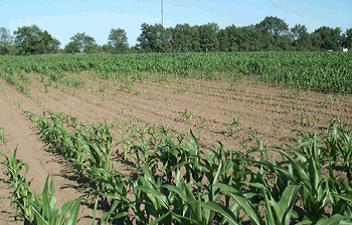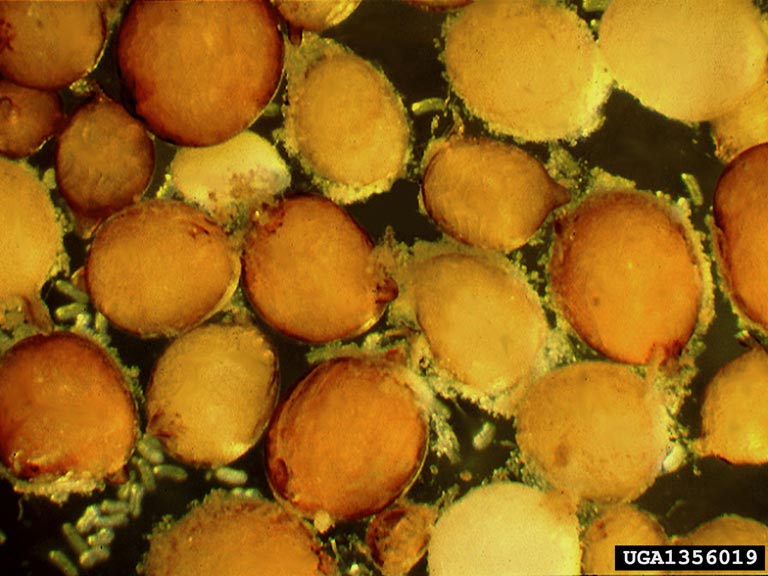
Maize cyst nematode
| Primefact number | Edition | Published | Author |
|---|---|---|---|
| 1507 | First | Aug 2017 | Plant Biosecurity and Product Integrity |


Maize cyst nematode (Heterodera zeae) is an exotic plant pest not present in Australia. This nematode is a serious threat to Australia’s grain industry.
Maize cyst nematode (Heterodera zeae) is a plant-parasitic nematode that is an important pest of maize in warm climates. It is also known as the corn cyst nematode.
Young maize cyst nematodes infest the roots of maize crops while the adult female nematodes become egg filled cysts.
Notifiable status
Maize cyst nematode (Heterodera zeae) is not a notifiable plant pest in NSW.
However, if you suspect maize cyst nematode (Heterodera zeae):
- Call the Exotic Plant Pest Hotline 1800 084 881
- Email biosecurity@dpi.nsw.gov.au with a clear photo and your contact details
A full list of notifiable plant pests and diseases can be found in Schedule 2 of the NSW Biosecurity Act 2015.
Description
Maize cyst nematodes are small worms which live on plant roots. Female nematodes look like small white lemon-shaped balls protruding from the maize root. These pinhead sized balls can be seen by the unaided eye.
Patches of pale green, stunted maize plants are one of the first signs of infestation (Figure 1). Slow leaf emergence and poorly developed root systems are other symptoms of infestation.
Infestations may be confirmed by sighting white female nematodes or brown nematode cysts on the maize roots (Figure 2). However this identification should be verified by a certified diagnostic nematology laboratory.
Damage
Maize cyst nematode can cause 70% yield losses in infested maize crops.
The maize cyst nematodes damage the plant roots, causing nutrient deficiency symptoms which require extra fertilizer to curb yield losses.
Maize cyst nematode damage can appear similar to the effects of drought stress, nutrient deficiency or herbicide damage.
Lifecycle
Maize cyst nematodes can complete six to seven life cycles in a cropping season and each female lays up to 150 eggs.
Maize cyst nematodes have three lifecycle stages: eggs, juveniles and adults. Juvenile nematodes emerge from the eggs after warm soil temperatures. The juvenile females invade the maize roots and establish fixed feeding sites. The optimum soil temperatures for egg hatching and root penetration are 25-33°C.
As female nematodes grow they swell up with eggs and rupture the plant root. When the adult females die their egg-filled dead bodies harden and become nematode cysts, which change colour from white to brown.
As the egg-filled nematode cysts are resistant to dehydration, the eggs inside them can remain viable for several years.
Host range
The main host plant of maize cyst nematode is maize. Other hosts include barley, foxtail millet, grasses, oats, rice, sorghum, Sudan grass and wheat.
Spread
Maize cyst nematodes can be spread from farm-to-farm in cyst infested plant material or soil particles by farm machinery, footwear, humans, livestock, vehicles, water and wind.
Juvenile nematodes can move through the soil from their eggs to host plants.
Distribution
Maize cyst nematodes are found in Afghanistan, Egypt, Greece, Portugal, India, Indonesia, Iran, Iraq, Nepal, Pakistan, Thailand and the United States of America.
Actions to minimise risks
Put in place biosecurity best practice actions to prevent entry, establishment and spread of pests and diseases:
- practice “Come clean, Go clean”
- ensure all staff and visitors are instructed in and adhere to your business management hygiene requirements
- source seed of a known high health status from reputable suppliers
- monitor your crop regularly
- keep records

